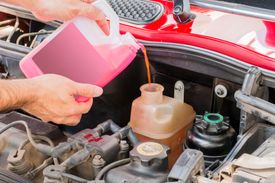How to Keep Your Transmission From Overheating

Several factors cause an overheating transmission, but most of them boil down to the fluid. The transmission fluid lubricates gears and absorbs the heat produced by friction. Over time, it breaks down and becomes ineffective at removing the heat. If left unchecked by a transmission service technician, it can severely damage your system. In the meantime, here are some tips for keeping your transmission from running too hot.
4 Ways to Avoid Transmission Overheating
1. Check Transmission Fluid Regularly
The primary function of the transmission fluid is to take excess heat away from the radiator by cooling it and returning it to the system for another run. For the fluid to be efficient, it needs to have a temperature of 175 degrees Fahrenheit—once it exceeds 200 degrees, it’s too hot.
Burnt or old fluid does little to dissipate heat, so make sure to examine its condition frequently. Pay attention to the liquid’s color—a brownish to black hue is a telltale sign it’s time for a replacement. Using a dipstick, check the levels to know whether you still have enough for efficient cooling. Look under the vehicle as well for leaks if fluid levels are dropping.
2. Opt for a Fluid Exchange
If it has been a while  since you visited a transmission service shop for a flush or exchange, you’re likely running with burnt or stale fluid. Schedule a fluid change regularly, or at least every 30,000 to 60,000 miles. However, consider having it flushed at shorter intervals if you drive under harsh conditions like hot climates, rough roads, or stop-and-go traffic, or if you haul heavy loads — these circumstances tend to wear out the fluid faster.
since you visited a transmission service shop for a flush or exchange, you’re likely running with burnt or stale fluid. Schedule a fluid change regularly, or at least every 30,000 to 60,000 miles. However, consider having it flushed at shorter intervals if you drive under harsh conditions like hot climates, rough roads, or stop-and-go traffic, or if you haul heavy loads — these circumstances tend to wear out the fluid faster.
3. Install a Transmission Cooler
For vehicles that tow heavy loads, add a dedicated transmission cooler. Depending on the type, you can attach it to the radiator for faster cool down times. Some coolers even come with built-in fans. You can also have a temperature gauge installed at a transmission service shop to know at a glance if the fluid is running too hot.
4. Add a Deep Pan
Another modification for averting overheating is to install a deep pan, which lets you add more transmission fluid. Pouring in more fluid cools your transmission faster, especially when the heat gets spread out. Consider a deeper pan made from aluminum instead of steel for better, more effective heat dissipation.
Frequent overheating will be the death of your transmission system. Pay attention to signs of overheating and take your car for maintenance at Quality Transmission Service. Serving motorists throughout Anchorage, AK, their ASE®-certified mechanics offer top-notch service of manual and automatic transmissions. Call (907) 561-8767 to schedule auto repairs or visit their website to learn more about coolers and temperature gauge installations.
About the Business
(106 reviews)
Have a question? Ask the experts!
Send your question

